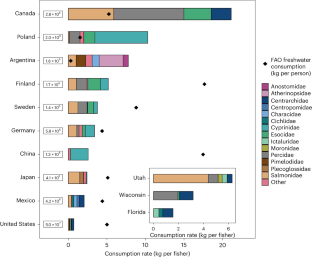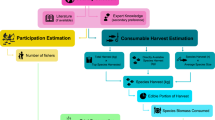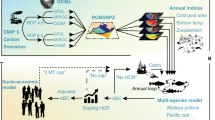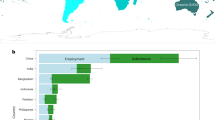Abstract
Inland recreational fishing is primarily considered a leisure-driven activity in freshwaters, yet its harvest can contribute to food systems. Here we estimate that the harvest from inland recreational fishing equates to just over one-tenth of all reported inland fisheries catch globally. The estimated total consumptive use value of inland recreational fish destined for human consumption may reach US$9.95 billion annually. We identify Austria, Canada, Germany and Slovakia as countries above the third quantile for nutrition, economic value and climate vulnerability. These results have important implications for populations dependent on inland recreational fishing for food. Our findings can inform climate adaptation planning for inland recreational fisheries, particularly those not currently managed as food fisheries.
This is a preview of subscription content, access via your institution
Access options
Access Nature and 54 other Nature Portfolio journals
Get Nature+, our best-value online-access subscription
$29.99 / 30 days
cancel any time
Subscribe to this journal
Receive 12 digital issues and online access to articles
$119.00 per year
only $9.92 per issue
Buy this article
- Purchase on Springer Link
- Instant access to full article PDF
Prices may be subject to local taxes which are calculated during checkout




Similar content being viewed by others
Data availability
The raw and formatted datasets and accompanying metadata for the species-specific inland recreational fisheries harvest estimates for consumption as well as the nutrition, economic value and climate vulnerability data are freely available to the public, supported by the US Geological Survey National Climate Adaptation Science Center (https://doi.org/10.5066/P9904C3R (ref. 40) and https://doi.org/10.5066/P9WO91SZ (ref. 15), respectively). The Aquatic Foods Composition Database is freely available (https://doi.org/10.7910/DVN/KI0NYM (ref. 41)), and the GND is available upon request. The data to support the currency conversions used in this study are available from Bloomberg. Restrictions apply to the availability of these data, which were used under license for this study. Data are available with the permission of Bloomberg (https://bba.bloomberg.net/). Climate change data from Nyboer et al.20 are available through the Open Science Framework (https://osf.io/keajr/).
References
Welcomme, R. L. et al. Inland capture fisheries. Philos. Trans. R. Soc. Lond. B 365, 2881–2896 (2010).
State of World Fisheries and Aquaculture 2022 (FAO, 2022).
Hicks, C. C. et al. Harnessing global fisheries to tackle micronutrient deficiencies. Nature 574, 95–98 (2019).
Golden, C. D. et al. Aquatic foods to nourish nations. Nature 598, 315–320 (2021).
Golden, C. D. et al. Nutrition: fall in fish catch threatens human health. Nature 534, 317–320 (2016).
Nyboer, E. A., Liang, C. & Chapman, L. J. Assessing the vulnerability of Africa’s freshwater fishes to climate change: a continent-wide trait-based analysis. Biol. Conserv. 236, 505–520 (2019).
Tigchelaar, M. et al. Compound climate risks threaten aquatic food system benefits. Nat. Food 2, 673–682 (2021).
Fluet-Chouinard, E., Funge-Smith, S. & Mcintyre, P. B. Global hidden harvest of freshwater fish revealed by household surveys. Proc. Natl Acad. Sci. USA https://doi.org/10.1073/pnas.1721097115 (2018).
Ainsworth, R. F., Cowx, I. G. & Funge-Smith, S. J. Putting the fish into inland fisheries—a global allocation of historic inland fish catch. Fish Fish. 24, 263–278 (2023).
Cooke, S. J. et al. The nexus of fun and nutrition: recreational fishing is also about food. Fish Fish. 19, 201–224 (2018).
Nyboer, E. A. et al. Overturning stereotypes: the fuzzy boundary between recreational and subsistence inland fishereis. Fish Fish. 23, 1282–1298 (2022).
Thorpe, A., Zepeda, C. & Funge-Smith, S. in Review of the State of the World Fishery Resources: Inland Fisheries (ed Funge-Smith, S.) 214–253 (FAO, 2018).
Arlinghaus, R. Voluntary catch-and-release can generate conflict within the recreational angling community: a qualitative case study of specialised carp, Cyprinus carpio, angling in Germany. Fish. Manag. Ecol. 14, 161–171 (2007).
Embke, H. S. et al. Global dataset of species-specific inland recreational fisheries harvest for consumption. Sci. Data 9, 488 (2022).
Lynch, A. J. et al. Global dataset of nutritional value, economic value, and climate vulnerability for species-specific recreational fisheries harvest for consumption: U.S. Geological Survey data release. USGS ScienceBase https://doi.org/10.5066/P9WO91SZ (2023).
Schmidhuber, J. et al. The Global Nutrient Database: availability of macronutrients and micronutrients in 195 countries from 1980 to 2013. Lancet Planet. Health 2, e353–e368 (2018).
Weithman, S. in Inland Fisheries Management in North America (eds. Kohler, C. C. & Hubert, W. A.) 193–213 (American Fisheries Society Press, 1999).
Arlinghaus, R., Mehner, T. & Cowx, I. G. Reconciling traditional inland fisheries management and sustainability in industrialized countries, with emphasis on Europe. Fish Fish. 3, 261–316 (2002).
Parkkila, K. et al. European Inland Fisheries Advisory Commission Methodologies for Assessing Socio-Economic Benefits of European Inland Recreational Fisheries EIFAC Occasional Paper No. 46 (FAO, 2004).
Nyboer, E. A. et al. Global assessment of marine and freshwater recreational fish reveals mismatch in climate change vulnerability and conservation effort. Glob. Chang. Biol. 27, 4799–4824 (2021).
Willett, W. et al. Food in the Anthropocene: the EAT–Lancet Commission on healthy diets from sustainable food systems. Lancet 393, 447–492 (2019).
Simmance, F. A. et al. Nudging fisheries and aquaculture research towards food systems. Fish Fish. 23, 34–53 (2022).
Aas, Ø. & Ditton, R. B. in Recreational Fisheries: Social, Economic and Management Aspects (eds Hickley, P. & Tompkins, H.) 153–164 (Wiley-Blackwell, 1998).
Hutt, C. P. & Neal, J. W. Arkansas urban resident fishing site preferences, catch related attitudes, and satisfaction. Hum. Dimens. Wildl. 15, 90–105 (2010).
Embke, H. S., Beard, T. D., Lynch, A. J. & Vander Zanden, M. J. Fishing for food: quantifying recreational fisheries harvest in Wisconsin lakes. Fisheries 45, 647–655 (2020).
Arlinghaus, R. et al. Governing the recreational dimension of global fisheries. Proc. Natl Acad. Sci. USA 116, 5209–5213 (2019).
Joosse, S., Hensle, L., Boonstra, W. J., Ponzelar, C. & Olsson, J. Fishing in the city for food—a paradigmatic case of sustainability in urban blue space. Urban Sustain. 1, 41 (2021).
Hunt, L. M. et al. Identifying alternate pathways for climate change to impact inland recreational fishers. Fisheries 41, 362–372 (2016).
Gregory, P. J., Ingram, J. S. I. & Brklacich, M. Climate change and food security. Philos. Trans. R. Soc. Lond. B 360, 2139–2148 (2005).
Ahrens, R. N. M., Allen, M. S., Walters, C. & Arlinghaus, R. Saving large fish through harvest slots outperforms the classical minimum-length limit when the aim is to achieve multiple harvest and catch-related fisheries objectives. Fish Fish. 21, 483–510 (2020).
Arlinghaus, R., Tillner, R. & Bork, M. Explaining participation rates in recreational fishing across industrialised countries. Fish. Manag. Ecol. 22, 45–55 (2015).
Arlinghaus, R. et al. Global participation in and public attitudes toward recreational fishing: international perspectives and developments. Rev. Fish. Sci. Aquac. 29, 58–95 (2021).
Bower, S. D. et al. Knowledge gaps and management priorities for recreational fisheries in the developing world. Rev. Fish. Sci. Aquac. 28, 518–535 (2020).
Grove, E. W. & Koffsky, N. M. Measuring the incomes of farm people. Am. J. Agric. Econ. 31, 1102–1111 (1949).
Arslan, A. & Taylor, J. E. Farmers’ subjective valuation of subsistence crops: the case of traditional maize in Mexico. Am. J. Agric. Econ. 91, 956–972 (2009).
Kerrison, G. Impact Summary: Importation of Trout Meat for Sale (New Zealand Department of Conservation, 2018); https://www.doc.govt.nz/globalassets/documents/about-doc/role/legislation/importation-trout-meat-products-ris.pdf
Conversion Factors: Landed Weight to Live Weight FAO Fisheries Circular No. 847, Rev. 1 (FAO, 2000).
Funge-Smith, S. Review of the State of the World Fishery Resources: Inland Fisheries FIAF/C94 376 (FAO, 2018).
Funge‐Smith, S. & Bennett, A. A fresh look at inland fisheries and their role in food security and livelihoods. Fish Fish. 20, 1176–1195 (2019).
Embke, H. S. Global dataset of species-specific inland recreational fisheries harvest for consumption: U.S. Geological Survey data release. USGS ScienceBase https://doi.org/10.5066/P9904C3R (2022).
Golden, C. D. et al. Aquatic food composition database. Harvard Dataverse, V3, UNF:6:G2NfnhHcpldBlD6+PqPVVw== [fileUNF] https://doi.org/10.7910/DVN/KI0NYM (2021).
Acknowledgements
We thank data providers for their generosity with their time in contributing to this research and the InFish network (http://infish.org/) for assistance in connecting us with appropriate data providers. In addition to the contributors detailed in Embke et al.14, the following contacts provided additional data: O. Badunenko, M. Bavinck, S. Berg, I. Chatziantoniou, C. Chen, A. Froschauer, K. Gorski, Ø. Hermansen, F. I. Nworie, E. Karimov, T. Marković, A. Martinovska-Stojcheska, J. M. Q. Montiel, N. Novakov, A. Novoa, C. Rodriguez Da Costa Doria, R. Sagitova, P. Shipkov and A. Stenfors. We thank S. Sethi (Brooklyn College) for conducting an internal review of this paper for the US Geological Survey. This work received no dedicated funding. Any use of trade, firm or product names is for descriptive purposes only and does not imply endorsement by the US Government.
Author information
Authors and Affiliations
Contributions
A.J.L., A.T., T.D.B., C.B., S.J.C., I.G.C. and O.L.F.W. jointly conceptualized the project. A.J.L., H.S.E., E.A.N., L.E.W., A.T., S.C.P., D.F.V., C.D.G., M.M. and A.M.R. assembled and analysed the data. All authors, with the exception of O.L.F.W., discussed the results and implications and commented on the paper at all stages.
Corresponding author
Ethics declarations
Competing interests
The authors declare no competing interests.
Peer review
Peer review information
Nature Food thanks Kieran Hyder, M. Aaron MacNeil and the other, anonymous, reviewer(s) for their contribution to the peer review of this work.
Additional information
Publisher’s note Springer Nature remains neutral with regard to jurisdictional claims in published maps and institutional affiliations.
Extended data
Extended Data Fig. 1 Univariate maps of analyzed metrics.
Univariate maps showing: A - total consumption (kg per fisher); B - total consumptive use value (TCUV in USD) per recreational fisher as a share of 2021 gross domestic product (GDP) per capita; C - climate vulnerability (summed, weighted by proportions of species consumption (using scenario Representative Concentration Pathway [RCP]4.5, 2075 projection) and D - average nutritional contribution.
Extended Data Fig. 2 Relative contribution of micronutrients from recreational inland fish.
Comparison of the contribution of recreational inland fish to micronutrients (A - calcium, B - omega-3 long-chain polyunsaturated fatty acids docosahexaenoic acid and eicosapentaenoic acid [DHA + EPA], C - iron, D - protein, E - vitamin B12 [Vit B12], and F - zinc) as a proportion (%) of estimated national-level average per capita consumption from aquatic foods.
Extended Data Fig. 3 Prevalence of inadequate micronutrient intake.
Prevalence of inadequate micronutrient intake across all assessed nutrients and countries based on previously published study (Golden et al.4). Prevalence of inadequate intake was calculated using the summary exposure values, which estimates the population-level risk related to diets by comparing intake distributions with average requirements. Estimated prevalence of inadequate intake ranges from 0% (no risk) to full population-level risk (100%).
Extended Data Fig. 4 Total consumptive use value.
Comparison of A - total consumptive use value (TCUV in USD), B - TCUV per recreational inland fisher, C - TCUV per fisher corrected for gross domestic product (GDP), and D - TCUV per fisher corrected for GDP per capita corrected for purchasing power parity (PPP).
Extended Data Fig. 5 Climate vulnerability of consumed inland recreational fish.
Comparison of climate vulnerability of consumed inland recreational fish (weighted by proportion consumed) across four vulnerability scenarios (A - Representative Concentration Pathway [RCP]4.5, 2030; B - RCP8.5, 2030; C - RCP4.5 2075; D - RCP8.5, 2075).
Supplementary information
Rights and permissions
About this article
Cite this article
Lynch, A.J., Embke, H.S., Nyboer, E.A. et al. Inland recreational fisheries contribute nutritional benefits and economic value but are vulnerable to climate change. Nat Food 5, 433–443 (2024). https://doi.org/10.1038/s43016-024-00961-8
Received:
Accepted:
Published:
Issue Date:
DOI: https://doi.org/10.1038/s43016-024-00961-8



